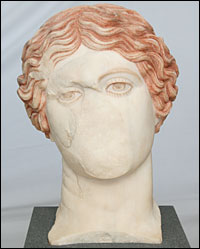
The most common material associated with the cultures of ancient Greece and Rome is marble. Anyone who has ever visited an art museum has seen countless Greek and Roman heads, torsos and full bodied statues in all of their white, shinny austerity. The image of the ancient white marble statue is extremely pervasive and most people don't realize the truth about these magnificent works of art. Ever since artists in the Renaissance began to look at ancient statuary for artistic influence, they utilized not only the themes and styles of ancient art, but the material as well. The statues that surfaced in the Renaissance for the most part were devoid of paint due to the ravages of time, and it's the starkness of marble that inspired artists of that time. In the following centuries though, it began to be understood that these statues were painted. Statues with their paint still intact began to be uncovered and a more complete picture of what the ancient world looked like began to take shape.
Sunday, March 15, 2009
The Ancient World in Technicolor
Archaeologists and scholars have known for a long time that the ancient world was one of color, not plain white marble. The public, though, to a large degree still imagines a Rome or Athens that was blindingly white in the mid-day sun. There have been some recent efforts to educate the public about ancient statue painting, the most comprehensive and successful being Gods in Color: Painted Sculpture in Classical Antiquity. This exhibit used state of the art technology to uncover the long lost paint and used fully sized and painted replicas of famous statues to get the point across. The result was amazing. Another recent effort is described in the article linked below. In this case, a team of archaeologists and scholars are attempting to reconstruct a statue of a wounded Amazon which has a considerable amount of paint in situ. The results of this team's work is bound to be another important addition to art history and archaeology.
Posted by
Primvs Pilvs
at
11:38 AM
![]()
Subscribe to:
Post Comments (Atom)








1 comments:
Very interesting. I never knew they were painted.
Post a Comment